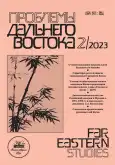About the New Concept of National Security of Japan
- Autores: Streltsov D.V.1,2
-
Afiliações:
- Moscow State Institute of International Relations (MGIMO-University)
- Institute of China and Contemporary Asia, RAS
- Edição: Nº 2 (2023)
- Páginas: 9-25
- Seção: Articles
- URL: https://journals.rcsi.science/0131-2812/article/view/142487
- DOI: https://doi.org/10.31857/S013128120025335-9
- ID: 142487
Texto integral
Resumo
Sobre autores
Dmitry Streltsov
Moscow State Institute of International Relations (MGIMO-University); Institute of China and Contemporary Asia, RAS
Email: pdvjournal@mail.ru
76, Vernadskogo Prospect, Moscow, 119454, Russian Federation
Bibliografia
- Добринская О.А. Реформы Абэ Синдзо в сфере политики обеспечения национальной безопасности // Япония: консервативный поворот / рук. проекта Э.В. Молодякова. М.: АИРО-XXI, 2015. С. 236–257.
- Киреева А. А., Нелидов В. В. Прошлое и настоящее Сил самообороны Японии: роль в государстве, обществе и на международной арене // Ежегодник Япония. 2018. Т. 47. С. 29–54. doi: 10.24411/0235–8182–2018–10002
- Крячкина Ю.А. Специфика формирования оборонной политики Японии при кабинете Синдзо Абэ // Проблемы национальной стратегии. 2021. № 2 (65). С. 70–84. doi: 10.52311/2079–3359_2021_2_70
- Нелидов В.В. Военная политика Японии на современном этапе: мотивация, задачи, перспективы // Проблемы Дальнего Востока. 2017. № 4. С. 88–96.
- Чугров С.В., Карелова Л.Б. Япония как «обычная страна»: метаморфозы политической идентичности (аналитический обзор опросов общественного мнения) // Социологический журнал. 2020. № 1 (26). С. 87–108. doi: 10.19181/socjour.2020.26.1.7054
- National Defense Strategy of the United States of America // U.S. Department of Defense. October 27, 2022. URL: https://media.defense.gov/2022/Oct/27/2003103845/-1/-1/1/2022-NATIONAL-DEFENSE-STRATEGY-NPR-MDR.PDF P.4 (дата обращения: 24.02.2023).
- Advantage at Sea. Prevailing with Integrated All-Domain Naval Power // U.S. Department of Defense. December 16, 2020. URL: https://media.defense.gov/2020/Dec/16/2002553074/-1/-1/0/TRISERVICESTRATEGY.PDF. FOREWORD (дата обращения: 24.02.2023).
- Ryan Ashley. Japan’s New National Security Strategy Is Making Waves // The Foreign Policy Research Institute. January 4, 2023. URL: https://www.fpri.org/article/2023/01/japans-new-national-security-strategy-is-making-waves/ (дата обращения: 24.02.2023).
- Schoff James L., Hana Anderson, and David Song. Tracking Japan’s Military Strike Debate // Carnegie Endowment for International Peace. URL: https://carnegieendowment.org/programs/asia/japan-military-strike-debate/ (дата обращения: 24.02.2023).
- Takahashi S. Dealing with the Ballistic Missile Threat: Whether Japan Should Have a Strike. Capability under its Exclusively Defense-oriented Policy // NIDS Security Reports. September 2006. No. 7. URL: http://www.nids.mod.go.jp/english/publication/kiyo/pdf/bulletin_e2006_4_takahashi.pdf. Pp. 79–94. (дата обращения: 24.02.2023).
- Wright J. Japan’s Self-Imposed One Percent: Does It Really Matter? // Journal of Indo-Pacific Affairs. July 12, 2022. URL: https://www.airuniversity.af.edu/JIPA/Display/Article/3089775/japans-self-imposed-one-percent-does-it-really-matter/ (дата обращения: 24.02.2023).
- 国家安全保障戦略について (О стратегии обеспечения национальной безопасности) // 内閣官房. 「国家安全保障戦略」(平成25年12月17日 国家安全保障会議・閣議決定). URL: https://www.cas.go.jp/jp/siryou/131217anzenhoshou/nss-j.pdf P. 21 (дата обращения: 24.02.2023).
- 国家安全保障戦略について (О стратегии обеспечения национальной безопасности) // 内閣官房. 「国家安全保障戦略」(令和4年12月16日 国家安全保障会議・閣議決定). URL: https://www.cas.go.jp/jp/siryou/221216anzenhoshou/nss-j.pdf (дата обращения 24.02.2023).
- 国家防衛戦略について (О Национальной стратегии в области обороны) // 内閣官房.「国家防衛戦略」(令和4年12月16日 国家安全保障会議・閣議決定. URL: https://www.cas.go.jp/jp/siryou/221216anzenhoshou/boueisenryaki.pdf (дата обращения: 24.02.2023).
- 防衛力整備計画について (О Среднесрочном плане оборонного строительства) // 内閣官房.「防衛力整備計画」(令和4年12月16日 国家安全保障会議・閣議決定). URL: https://www.cas.go.jp/jp/siryou/221216anzenhoshou/boueiryokuseibi.pdf (дата обращения: 24.02.2023).









